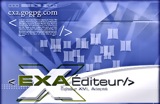ONIX
ONIX - ONline Information eXchange
Objective/Definition
According to Editeur, the group responsible for the maintenance of the ONIX standard, “ONIX is the international standard for representing book, serial, and video product information in electronic form.” [1]
Editeur objectives are: • To cover books and, progressively, other media. • To meet the practical information needs of all sectors of the industry, including in particular, but not limited to, publishers and online vendors. • To provide structures which can reflect the realities of national and international rights, distribution, pricing and availability. • To be usable in a multilingual marketplace. • To incorporate the core content which has been specified in national initiatives such as BIC Basic and AAP’s ONIX project. • Finally, to build where possible on what EDItEUR’s EPICS and the <indecs> Project had already done to establish sound models for metadata in a future electronic environment. In a recent press release from the International DOI Foundation stated that one of the key aims of ONIX “is to provide a format for delivery structured data, and to that end ONIX has a much more highly structured model for information than other descriptive metadata formats, such as Dublin Core.” [2]
Constituency
ONIX is maintained cooperatively by three bodies: 1. EDITEAR : an international group, which coordinates standards for electronic commerce. https://www.editeur.org/onix.html 2. Book Industry Communications (BIC) : a London based organization charged with exploring electronic data interchange. https://www.bic.org.uk/ 3. Book Industry Study Group (BISG) : a non-profit association stationed in New York, which develops technical standards for the book world. https://www.bisg.org/
Who uses ONIX? Many major online book traders use ONIX as their standard. Among the many groups involved with ONIX Amazon played an intricate role in its initial use. Below find a listing of some groups that use ONIX:
American Booksellers Association American BookSense Website Association of American Publishers Association of American University Presses American Wholesale Booksellers Association Amazon.com Barker & Taylor Barnes & Noble Bowker Follet Harcourt HarpersCollins Houghton Mifflin Ingram Books Company Login Brothers McGraw-Hill MUZE National Book Network Net read Paladin Press Pearson Princeton University Press Random House, Inc. Reiter’s Time Warner Publishing John Wiley & Sons Yale University Press
Evolution
• The name ONIX and the idea of a standard aimed primarily at enabling publishers to supply “rich” product information to Internet booksellers originated with a meeting in July 1999 organized by the Association of American Publishers (AAP) and attended by over sixty publishers, online booksellers, and others. • As a result of that meeting, the AAP funded and managed a fast-track project during the last quarter of 1999, which led to the publication of ONIX Version 1 in January 2000. • Much of ONIX is based on a pre-existing standard called EPICS (EDITEUR Product Information Communication Standards). • Originally designed with 2 levels. Level 1 was conceived as a simplified subset, which would be sufficient to meet the needs of many, particularly smaller, book publishers. • The overwhelming majority of implementations have been at the level 2; the ONIX development team decided not to further develop level 1. • Latest release is version 2.0, which introduces coverage of ebooks; adds many new elements and codes which have been requested by user groups; and makes some structural changes which will enable coverage to be extended more widely to non-book media, and facilitate the structured description of product content, including book tables of contents. ONIX E-publication Type codes (available at https://www.editeur.org/onix.html) are an essential part of the description of ebooks. Because of the speed of change in this area, they are being maintained and updated separately from the rest of Release 2.0.
Prerequisites
• Understanding of XML data type
Content
The ONIX documentation type definition (DTD) contains over 230 data elements and composite elements, organized into 38 groups: 25 of which relate to product records, 6 to main series records and 7 to subseries records.
ONIX defines optional and mandatory data element for a wide range of media including : cover images, author photos, audio files, video, ect.
ONIX is written using XML tags that refer to the ONIX Documentation Type Definition (DTD). The DTD defines the required an optional elements, repeatability and ordering of elements.
Illustration
Representation of ONIX message series, which is one of the four series types that are part of the ONIX metadata schema.
